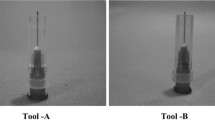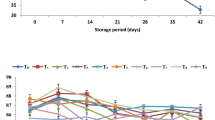Abstract.
Fresh-cut Amarillo melon was stored under passive modified atmosphere packaging (MAP) for 14 days at 5 °C. Three commercial films were tested: microperforated polypropylene (MPP), bioriented PP (BPP), and oriented PP (OPP). As a control, a macroperforated PP film was used. The effect of a citric acid dip treatment (0.52 mM) on the quality of the melon pieces packaged in OPP film was also evaluated. A similar final gas composition (4 kPa O2 plus 12–13 kPa CO2) within packages was achieved by using the three tested films. This atmosphere was effective for maintaining sensorial quality and microbial safety and for avoiding weight loss and translucency. When citric acid dip was applied, a reduction of microbial counts, a low discoloration, an increase of lightness, and a general improvement of visual appearance were found. However, after 14 days of storage, neither MAP treatments nor citric acid dip were enough to avoid softening of at least 23%, although the highest value (32%) was found in control pieces. Taking into account safety, quality attributes and consumer acceptance, shelf life of fresh processed melon stored under the studied MAP conditions could be stabilised for 10 days.


Similar content being viewed by others
References
Madrid M, Cantwell M (1993) Proceedings of the 6th International Controlled Atmosphere Research Conference. NRAES-71, Ithaca, NY, pp 736–745
Aguayo E, Escalona VH, Artés F (2001) Abstracts of the 8th International Controlled Atmosphere Research Conference. Rotterdam, Netherlands
Ayhan Z, Chism GM (1998) J Food Qual 21:29–40
Marston EV (1995) Cutting Edge 9:3-5
Nguyen-the C, Carlin F (1994) Crit Rev Food Sci Nutr 34:371–401
Bai JH, Saftner RA, Watada AE, Lee YS (2001) J Food Sci 66:1207–1221
Portela SI, Cantwell MI (1998) Postharvest Biol Technol 14:315–357
Gorny JR (1997) CA Proceedings, vol 5. Fresh-cut fruits and vegetables and MAP. University of California, Davis, CA, p 30
Aguayo E, Escalona VH, Artés F (2001) Horticultura Internacional 19 (6): 48–60
Watada AE, Ko PN, Minott DA (1996) Postharvest Biol Technol 9:115–125
Artés F, Martínez JA (1999) Eur Food Res Technol 209:330–334
Bolin HR, Huxsoll CC (1991) J Food Sci 56:416–418
Artés F, Escalona VH, Artés-Hdez (2002) Eur Food Res Technol 214:216–220
Artés F, Conesa MA, Hernández S, Gil MI (1999) Postharvest Biol Technol 17:153–162
Luna-Guzmán I, Cantwell M, Barrett DM (1999) Postharvest Biol Technol 17:201–213
Hong JH, Gross KC (1998) Postharvest Biol Technol 13:51–58
Madrid M (1993) MS Thesis, University of California, Davis, CA
RD 3484/2000 (2001) Boletín Oficial del Estado, Madrid, Spain, 11:1435–1441
Kato-Noguchi H, Watada AE, (1997) HortSci 32:136
Portela SI, Cantwell MI (2001) J Food Sci 66:1265–1270
Qi L, Wu T, Watada AE (1999) J Food Qual 22:513-521
Luna-Guzmán I, Barrett DM (2000) Postharvest Biol Technol 19:61–72
O'Connor-Shaw RE, Roberts R, Ford AL, Nottigham SM (1994) J Food Sci 59:1202–1206
Acknowledgements.
The authors are grateful to the Spanish CICYT, Project ALI 98–1006, for financial support and for grants to E. Aguayo and A. Allende. Thanks are also due to CEBAS-CSIC and to FRUCA CFM (Fuente Álamo, Murcia, Spain) for providing facilities and fruits respectively.
Author information
Authors and Affiliations
Corresponding author
Rights and permissions
About this article
Cite this article
Aguayo, E., Allende, A. & Artés, F. Keeping quality and safety of minimally fresh processed melon. Eur Food Res Technol 216, 494–499 (2003). https://doi.org/10.1007/s00217-003-0682-7
Received:
Revised:
Published:
Issue Date:
DOI: https://doi.org/10.1007/s00217-003-0682-7




